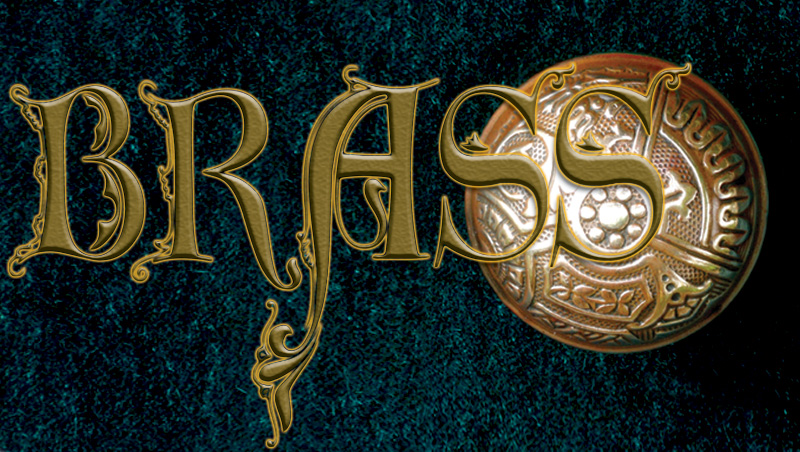
After reading Anna D’Ambrosio’s catalogue for the Munson-Williams-Proctor Arts Institute’s 2005 A Brass Menagerie: Metalwork of the Aesthetic Movement, I was disappointed because I had missed the show. I got a second chance to see it when late this summer (2007) the Bard Graduate Center for Studies in the Decorative Arts, Design, and Culture reconstituted the exhibition.
A show about American mass-produced brass might seem an odd choice to those familiar with the center’s little “jewel box” museum, past exhibitions, and fat, expensive catalogues, which have focused on the possessions of British and Continental rich and royal, past and present. But Americans (except for those few collectors of the possessions of British and Continental rich and royal, who don’t need to go to museums) tend to be jingoistic so they probably stayed away from those events in droves—if you’re not allergic to dust and you want to find peace and quiet within the pandemonium of a Sunday at The Metropolitan Museum of Art, just go to the French or, even better, Italian period installations. Bard’s exhibitions director Nina Stritzler-Levine told me Dr. Soros was looking to break into the crowd-pleasing Americana scene. Taking this preexisting little show may have been a cheap, easy way to test the waters since most of the objects came from local private collections. American brass was replaced by Fragile Diplomacy: Meissen Porcelain for European Courts on November 14, 2007. As much as I love Meissen, I think I’ll wait for their show about what in the King of Poland’s private pottery wasn’t made for European courts.
If Brass Menagerie didn’t fit Bard’s ideology, it nicely fit the scale of their Manhattan exhibition rooms. Andirons and coal hods, gasoliers and doorknobs, magazine stands and bookends all looked at home in the old townhouse parlors, which had had their usually neutral walls gussied up with fake burgundy and gold Aesthetic Movement wallpaper. The installation made the objects accessible in a surprising and not altogether positive way: While I was there a couple of women viewing the exhibit were more interested in where they had just seen an object like one on display and how they should have bought it than they were in whatever the labels had to say about the show’s thesis. Indeed the show had the feeling of a booth in an antiques show or a shop like Neary’s in Philadelphia. Many of the things displayed in protective cases or on pedestals were fresh from the market. Shopping the exhibition was fun, but perhaps not respectful of D’Ambrosio’s research. I found myself wondering if there was a distinction between mere collectible antiques and more lofty “decorative arts.”
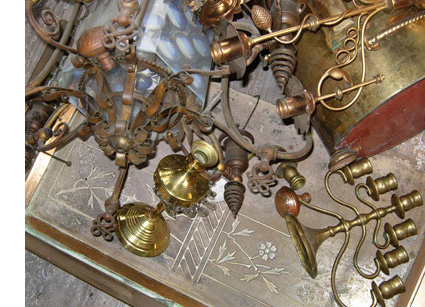
Decorative art?
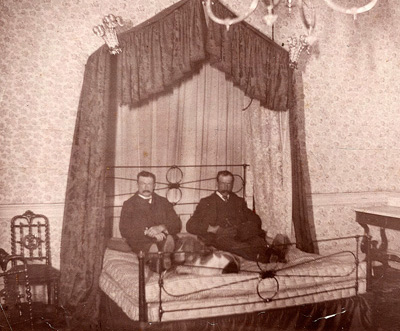 As mystifying as these strange bedfellows may be, there can be little doubt about their class or their classy brass bed. I know, I know, only the brass gasolier and the asymmetrical pattern on the spaniel are relevant to A Brass Menagerie: Metalwork of the Aesthetic Movement. |
A
A
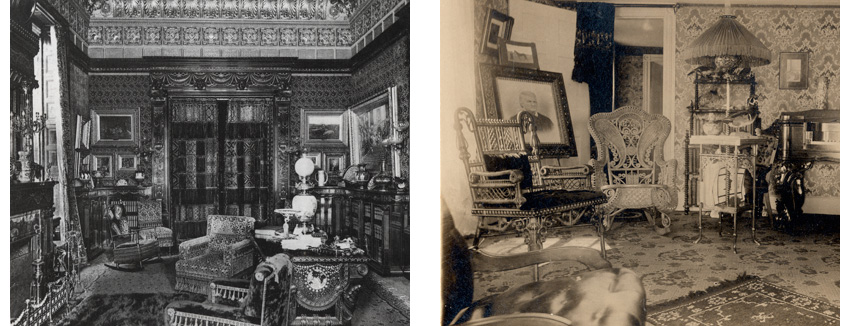
Convenient as well as stylish, combos like the lamp and table in the center of the photograph on the right were common during the Aesthetic Movement and still show up with some frequency at local auctions, but they didn’t show up at the Bard show or in the catalogue. This one brightens the parlor of a modest clapboard house in Scarborough, Maine; the easel in the corner is also made of brass. The room demonstrates how perfectly the elements of Aesthetic style translate from class to class. The furnishings in the William Vanderbilt house (left) differ only in the amount of expensive, exquisite workmanship and lavish use of precious materials. The taste of the decorators of both houses is, for better or worse, remarkably similar. I would argue that the Maine homeowner was more resourceful and creative than the rich city slicker because she (okay, “or he,” but I know it was a she) couldn’t afford to have everything custom made. She had to find the Japonesque wallpaper (visible through the door) and carpet, the “Persian” rug, the art pottery, and the asymmetrical, banded portiere from a catalogue or the local dry goods store, but she knew how to get the same effect as Vanderbilt got by paying a throng of designers, artisans, and laborers. Please notice that the combo lamp also serves as a “music rest”—that’s sheet music resting on the bottom shelf!
One might also wonder if it’s Aesthetic Movement because it is included in the catalogue. The creepy Guerin bird-claw floor lamp (#22) could be called Renaissance Revival and gives rise to questions about terminology. A scholarly endnote gives the patent title as “design for a lamp standard” without specifying “floor lamp” as does the catalogue. The lamp’s listed height of 42-1/2 inches is considerably shorter than the 66 inches listed for another “floor lamp” (#23 and also arguably Renaissance Revival)—in the absence of any contradicting evidence, I’m guessing the claw lamp was actually a banquet lamp, which, if the deep blue glass shade is original, must have cast a glow as spooky as the lamp itself when placed high on a table to light a party. Number 30 is called a “music rest,” suggesting a stand from which a musician might read sheet music, but the object couldn’t be used that way and more closely resembles the magazine racks so common in middle-class homes at the time.
|
|
The catalogue’s discussion of original finish is fascinating but also provides a little bit too much knowledge, which becomes a dangerous thing if one reads it before seeing the exhibition, where some objects have the flaky white brass-polish remnants of a careless home polishing job while others have been professionally restored to a blazing caramel color. The fabric inserts on some seem to be original while others seem to have overly elegant cut-velvet replacements. Originally ceramic tiles, fabric, onyx, and marble were used in tabletops. These were loosely fitted into metal framing and were often damaged by heavy plant pots or from falling out and breaking. A table (#20) belonging to the Dallas Museum of Art appears to have a modern black marble replacement top, which is not noted in the catalogue.
Then there are the glass prisms. One Table (#5) has an “apron” of impossibly slender glass rods, which appear to be breathtakingly fragile— they make a very strong contribution to the overall design of the table, yet they are far too vulnerable to be original and to have survived all these years. A pair of radically geometrical candlesticks was in the Bard exhibit but not in the catalogue. I have seen countless variations of these and all had glass prisms of one shape or another. I think I once bid at an estate auction for a pair exactly like the ones on exhibit, and mine came with glass prisms more ordinary than I could have wished for. The Bard sticks were shown without prisms, emphasizing their progressive design. Contrary to my experience, the label copy stated they probably came with brass pendants and hypothesized that brass would have been cheaper than glass. Glass or crystal prisms came in a wide range of qualities from real rock crystal to cut, lead glass to inexpensive pressed glass. The unstated fact is that today brass drops are far more rare than glass and their presence makes an object more desirable to the modern collector.
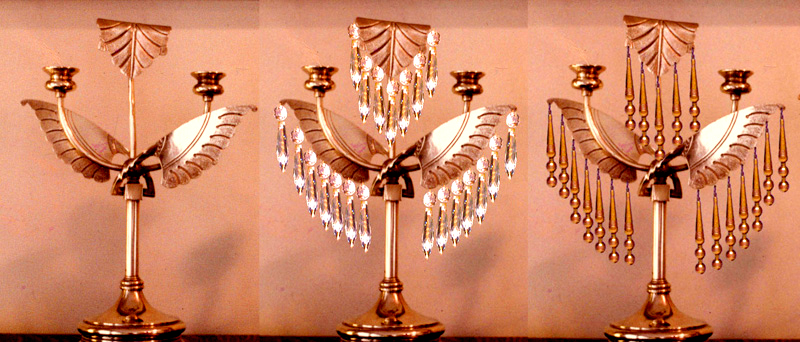
Brass candlesticks such as these are often associated with Christopher Dresser’s progressive designs. This pair also brings to mind Frank Furness and Philadelphia Modern Gothic, especially if the little holes at the tips of the “feathers” are ignored. But those holes make the designer’s regressive intentions irrefutable—they were meant for not-so-very-progressive crystal prisms. Some modern collectors might compromise the design by using brass pendants.
The crystal question makes clear the show’s conundrum: antiques or decorative arts or material culture? The actual objects fell into the antiques category. The fancy setting favored a decorative arts sobriquet. The history of usage and details of manufacture in the catalogue seemed to me to be material culture. This project was not big enough to encompass all three disciplines, but a choice was never made.
Buy the book anyway—it stands on its own!
